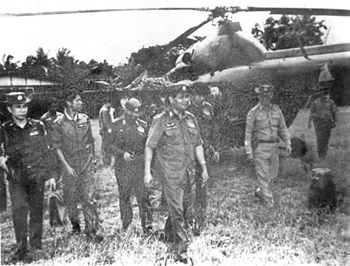Operation Delta
Was Snr-Gen Than Shwe really ignorant of the scale of the cyclone disaster? Or was he nursing old grudges against Karen guerillas in the delta?
TWO weeks after the Cyclone Nargis disaster, Burma’s reclusive leader Snr-Gen Than Shwe finally appeared in public touring showcase camps in the Irrawaddy delta.
In the wake of Burma’s greatest disaster in living memory, his absence from the spotlight and lack of response was seen as both cowardice and a major public relations gaffe.
 |
| Than Shwe, center, inspects Bogalay Township during “Operation Storm” in 1991. |
With the outcry from around the world echoing in his ears, it is difficult to believe the junta leader did not grasp the severity of the situation. Still, it seems particularly inhuman—even by Than Shwe’s standards—that he would willfully prevent humanitarian aid from reaching the cyclone victims.
One factor to consider is that, in the military regime’s eyes, the Irrawaddy delta has been a breeding ground of dissent since Burmese independence in 1948.
Many of the Karen rebels’ leaders have hailed from the delta and it has long been a popular recruiting ground for both the Karen National Union (KNU) and, until the 1970s, the Communist Party of Burma (CPB).
 Enlarge Image Enlarge Image |
| The “Operation Storm” campaign in 1991 took place in the townships of the Irrawaddy delta. |
Conflict in the Irrawaddy delta between rebels and the Tatmadaw (Burmese armed forces) is as old as the civil war itself—breaking out almost immediately after Burma won its independence from Britain in 1948.
At the Battle of Insein in 1949, the Burmese army, under the command of Ne Win, pushed the Karen rebels back from the outskirts of Rangoon to the Irrawaddy delta and to Karen State close to the Thai border.
The bloody battle produced a new generation of fighters in Burma, including Saw Ba Thin Sein, who later became chairman of the KNU, and who died in May 2008 at age 82.
The delta was also strategically important because of its proximity to Pegu Range and Arakan Range where communist and ethnic rebels had established their headquarters and armed bases.
Aware of the growing influence of Karen and communist rebels in the Irrawaddy delta, Ne Win and his commanders routinely launched military campaigns in the region, but were unable to wipe out the insurgency.
In 1971, Ne Win assigned Col Than Tin to lead the mission to turn the delta “white”—that is, to cleanse the area of insurgents once and for all.
Energetic and highly intelligent, Than Tin was transferred to the delta from Shan State where he had been on the front line fighting communist rebels.
He built detention facilities which he called “new villages”—though many would define them as concentration camps—where he relocated villagers who were suspected of being loyal to the CPB or the Karen National Defence Organisation (KNDO), the forerunner of the Karen National Liberation Army.
All new villages were situated close to military garrisons. Special commando units were instructed to launch sporadic searches in the villages. Whoever was found to be missing at the time of the raid would be assumed to be an insurgent.
San Yu, then commander in chief of the armed forces and Gen Ne Win’s protégé, briefed Than Tin on the instability in the delta and requested permission to undertake a clandestine counterinsurgency campaign in the rice-growing region.
1 | 2 | 3 next page »
